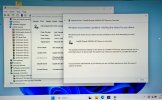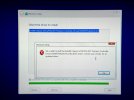Appletax
Well-Known Member
- Reaction score
- 385
- Location
- Northern Michigan
Edit: see this thread's post below. I think I botched the Optane memory permanently.
---
Client brought me an HP Spectre x360 - 13t-aw000 CTO laptop to repair. It had an issue with Explorer crashing.
Tried fixing it but ending up nuking and paving. Ran the built-in hardware diagnostics - no issues found.
The Intel Rapid Storage Technology Driver caused a BSOD (DRIVER_POWER_STATE_FAILURE). I reinstalled Win 11 multiple times trying different ways of installing this driver - tried installing it in the Win 11 USB installer, tried using different versions, tried letting Windows Updates handle it, tried installing it in Device Manager. It would process the driver for up to 11 minutes before crashing or reporting an error.
The laptop had a combo drive with 32GB Intel Optane Memory H10 and 512GB NVMe. I have very little experience with Optane. I made the mistake of not disabling Optane acceleration prior to N&P. In the Win 11 installer, I used Diskpart's clean command on both the SSD and the Optane memory. I could never figure out how to get Optane working again as the system kept saying that there were no valid disk pairs. I noticed that the SSD used a standard NVMe controller driver and that the Optane Memory used the Intel Chipset SATA/PCIe RST Premium Controller.
I replaced this combo drive with a standard NVMe drive and that didn't help at all. I decided to finish setting up Win 11 and see how it went. The BSOD never returned and the driver was installed. Hoping it stays that way for the client. If it happens again, I could use Group Policy Editor to prevent this specific controller from updating - it already comes with an older driver by default from the Win 11 installer.
This is such an odd issue. I wonder what the deal is. Maybe it's just another instance of junk HP consumer/residential-grade hardware. HP doesn't even have Windows 11 optimized drivers available for this system even though it's not that old.
Another issue is that when I tried moving Microsoft Edge, just once it caused the screen to briefly display a full screen lighter brown color with weird artifacts for just a split second.
It also has these really odd light bleed spots around the border of the screen - they are in various size thinner rectangles with lots of light bleed within but not out of the rectangle. Looks like a factory defect.
Also had an issue where the keyboard tended to now want to work in the Win 11 installer. The touchpad wouldn't work until after I installed a few drivers not including the touchpad driver itself. This computer has soldered on-board RAM.
Junk, junk, junk.
Specs: i7-1065G7, Iris Plus, 16GB LPDDR4x, 256GB NVMe, Win 11 Pro, USB-C power.




Mini dump file:
==================================================
Dump File : 082324-5921-01.dmp
Crash Time : 8/24/2024 1:16:32 AM
Bug Check String : DRIVER_POWER_STATE_FAILURE
Bug Check Code : 0x1000009f
Parameter 1 : 00000000`00000004
Parameter 2 : 00000000`0000012c
Parameter 3 : ffffb005`b56d0040
Parameter 4 : ffffe28a`ad8bf140
Caused By Driver : ntoskrnl.exe
Caused By Address : ntoskrnl.exe+4201c6
File Description :
Product Name :
Company :
File Version :
Processor : x64
Crash Address : ntoskrnl.exe+4201c6
Stack Address 1 :
Stack Address 2 :
Stack Address 3 :
Computer Name :
Full Path : C:\Windows\Minidump\082324-5921-01.dmp
Processors Count : 8
Major Version : 15
Minor Version : 22621
Dump File Size : 1,185,868
Dump File Time : 8/24/2024 1:16:50 AM
==================================================
---
Client brought me an HP Spectre x360 - 13t-aw000 CTO laptop to repair. It had an issue with Explorer crashing.
Tried fixing it but ending up nuking and paving. Ran the built-in hardware diagnostics - no issues found.
The Intel Rapid Storage Technology Driver caused a BSOD (DRIVER_POWER_STATE_FAILURE). I reinstalled Win 11 multiple times trying different ways of installing this driver - tried installing it in the Win 11 USB installer, tried using different versions, tried letting Windows Updates handle it, tried installing it in Device Manager. It would process the driver for up to 11 minutes before crashing or reporting an error.
The laptop had a combo drive with 32GB Intel Optane Memory H10 and 512GB NVMe. I have very little experience with Optane. I made the mistake of not disabling Optane acceleration prior to N&P. In the Win 11 installer, I used Diskpart's clean command on both the SSD and the Optane memory. I could never figure out how to get Optane working again as the system kept saying that there were no valid disk pairs. I noticed that the SSD used a standard NVMe controller driver and that the Optane Memory used the Intel Chipset SATA/PCIe RST Premium Controller.
I replaced this combo drive with a standard NVMe drive and that didn't help at all. I decided to finish setting up Win 11 and see how it went. The BSOD never returned and the driver was installed. Hoping it stays that way for the client. If it happens again, I could use Group Policy Editor to prevent this specific controller from updating - it already comes with an older driver by default from the Win 11 installer.
This is such an odd issue. I wonder what the deal is. Maybe it's just another instance of junk HP consumer/residential-grade hardware. HP doesn't even have Windows 11 optimized drivers available for this system even though it's not that old.
Another issue is that when I tried moving Microsoft Edge, just once it caused the screen to briefly display a full screen lighter brown color with weird artifacts for just a split second.
It also has these really odd light bleed spots around the border of the screen - they are in various size thinner rectangles with lots of light bleed within but not out of the rectangle. Looks like a factory defect.
Also had an issue where the keyboard tended to now want to work in the Win 11 installer. The touchpad wouldn't work until after I installed a few drivers not including the touchpad driver itself. This computer has soldered on-board RAM.
Junk, junk, junk.
Specs: i7-1065G7, Iris Plus, 16GB LPDDR4x, 256GB NVMe, Win 11 Pro, USB-C power.




Mini dump file:
==================================================
Dump File : 082324-5921-01.dmp
Crash Time : 8/24/2024 1:16:32 AM
Bug Check String : DRIVER_POWER_STATE_FAILURE
Bug Check Code : 0x1000009f
Parameter 1 : 00000000`00000004
Parameter 2 : 00000000`0000012c
Parameter 3 : ffffb005`b56d0040
Parameter 4 : ffffe28a`ad8bf140
Caused By Driver : ntoskrnl.exe
Caused By Address : ntoskrnl.exe+4201c6
File Description :
Product Name :
Company :
File Version :
Processor : x64
Crash Address : ntoskrnl.exe+4201c6
Stack Address 1 :
Stack Address 2 :
Stack Address 3 :
Computer Name :
Full Path : C:\Windows\Minidump\082324-5921-01.dmp
Processors Count : 8
Major Version : 15
Minor Version : 22621
Dump File Size : 1,185,868
Dump File Time : 8/24/2024 1:16:50 AM
==================================================
Last edited:
